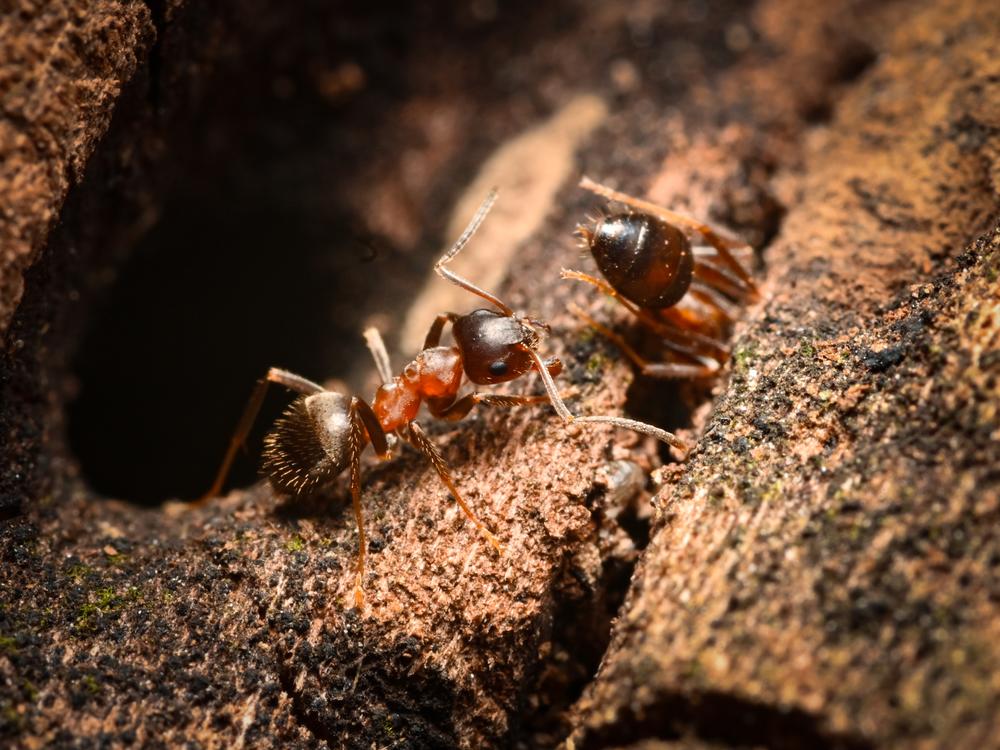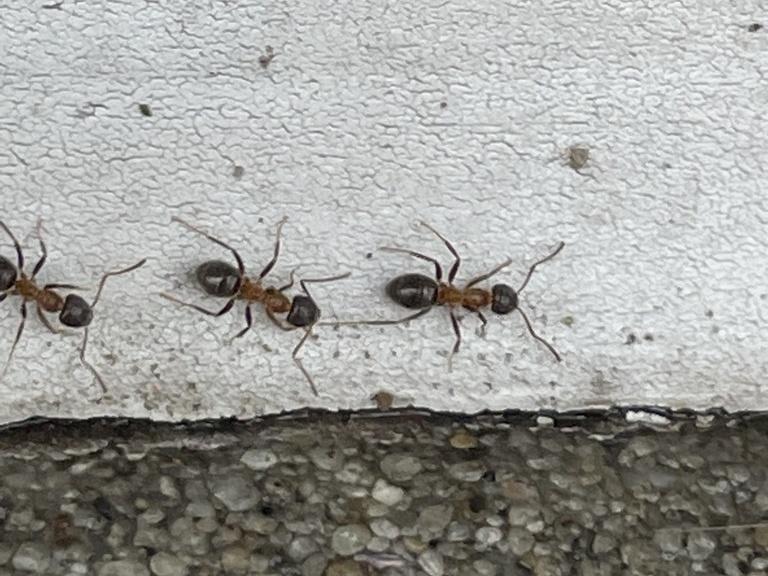Section Branding
Header Content
Meet the ManhattAnt, the ant that's taken New York's streets by storm
Primary Content
Frank Sinatra famously sang that if you can make it in New York, you can make it anywhere. And that’s just what worries some scientists who have been studying a particular species of ant.
This ant, nicknamed the ManhattAnt, first turned up in the city in 2011. Back then, no one knew where it came from, and for years it was mostly ignored.
But this ant has flourished in the Big Apple, so much so that it’s now vying with a species called the pavement ant for being the most common ant in the city, according to a report in the science journal Biological Invasions.
What’s more, ManhattAnts have started to spread beyond their namesake island, expanding their territory at a rate of about a mile a year.
“We predict that they could expand as far north as Maine and as far south as Atlanta, Georgia,” says Clint Penick of Auburn University. “This is an ant that could become quite common throughout the East Coast.”
He and some other scientists are now trying to figure out why it has been so successful, in order to better predict whether it’s likely to threaten native insect species or damage trees and other plants.
After all, tiny ants can sometimes cause big problems.
An influential list of the 100 worst invasive species worldwide includes a number of ants, points out Mariano Rodriguez-Cabal at the University of Vermont.
He says invasive species are a leading cause of extinction and biodiversity loss.
“We’re talking about a big, big issue here,” he says. “It’s not like just a crazy ant running around Manhattan.”
Getting to work in New York
This fairly large ant looks like no other species in the New York area, with a dark brown body and a reddish-orange midsection.
Before this ant first appeared in Manhattan, Rob Dunn, an ecologist at North Carolina State University, had been working with students to survey the various ant species of the city. These prior studies helped make it clear that this one was truly a new arrival.
The New York Post hailed it as “a new breed of ruffi-ant” living in “the Broadway medians at 63rd and 76th streets.”
Dunn and his team didn’t know what to make of the critter.
“There was this ant species that wasn’t supposed to be there,” says Dunn. “It was possible it was a species that was new to science, from somewhere else.”
The question of this ant’s true identity “sort of sat quietly in the corner, in our peripheral vision, while we did all kinds of other things in the city,” says Dunn.
Meanwhile, this ant was busy making itself at home: “Even when we weren’t doing that much work on it, it was doing lots of work on New York, Dunn says.
Eventually, Penick organized some genetic and body-shape studies that definitively identified it as Lasius emarginatus, a species that’s native to Europe.
That effort involved consulting with a European ant expert who could hardly believe that this ant was living it up in the city that never sleeps, Penick recalls.
“He was like, ‘Are you sure? Lasius emarginatus?’ He was like, ‘They’re not even really dominant in any European area,’” says Penick. “They’re not known as urban pests. So it was quite surprising that this species was the one that was taking over Manhattan.”
An ant in Times Square
This ant was, indeed, starting to dominate the island — although the vast majority of the more than 1.5 million human residents didn’t notice.
Its importance started to dawn on Penick as he continued to visit New York to study ants over the years, and found that this species “formed a larger and larger portion of the samples I was collecting.”
One day he traveled over to New Jersey, to stay at a friend’s place. When he got off the subway, he was surprised to see ManhattAnts underfoot.
“At this point, they had crossed the Hudson, and made it into New Jersey and were just living on the sidewalk,” he says.
That seemed weird, he says, as normally only the pavement ant hangs out on sidewalks. Other ants generally like to dwell in places like soil and leaf litter – including this species, which in its native Europe can be found making its home in forests.
But being surrounded by concrete and human activity does not seem to faze the ManhattAnt.
“We found a colony of them in a little flower planter box in the middle of Times Square, which was, I thought, pretty shocking,” says Samantha Kennett, a PhD student at Clemson University.
And while ants typically stick rather close to the ground, this species likes to climb way up, startling New Yorkers who aren’t used to seeing ants in high-rises.
“I was at someone’s rooftop the other day, on the sixteenth floor, and they marched by,” says Ellen van Wilgenburg, an insect researcher at Fordham University.
“They’re everywhere. They’re literally everywhere,” she says. “They’re on my stoop in front of my building. When I walk to work, or to the Trader Joe’s, I pass several colonies.”
Speed walking and street fighting
Ant species that get introduced into a brand new environment often form supercolonies, van Wilgenburg says. That means their nests all contain ants that are closely related and genetically similar, so the different nests don’t fight with each other.
That’s not the case with ManhattAnts.
Tests in the lab show that ants taken from different New York nests will treat each other like strangers and duke it out. Even neighboring nests that are physically close to each other, like in adjacent flower pots, can treat each other as dire enemies.
“They are very aggressive towards other ants, and you will see them carrying other ants’ bodies,” says Clancy McCann, a Fordham University student who’s been studying this ant with van Wilgenburg.
Izzie Kaplan, another Fordham student, says ManhattAnts — like many New Yorkers — are also speed walkers.
“They’re very fast, and that’s another reason why we’re super interested in them,” says Kaplan. Their speed may give them an advantage in the city as they compete with other species for resources.
In general, these ants eschew human food, although Kennett says her research shows that they will resort to whatever’s available in “really urban sidewalk habitats.”
Their main sustenance is honeydew, a kind of sugary poop excreted by aphids and scale insects.
The ants seem to be going up into street trees to forage for honeydew, says Kennett, and it may be that they’ve found a gig that’s not really being pursued by other ants in this city.
But ants that like honeydew will protect and care for the plant pests that produce it, increasing the numbers of pests and consequently making life harder for the plants. Invasive Argentine ants in California tend aphids in this way, for example, and have proven to be a real headache for citrus orchards there.
It’s “entirely possible” that, in the long term, ManhattAnts could have a negative effect on city trees, says Kennett, who says these ants seem to be foraging constantly, even at night. “I wish we could just see what they were doing all the time.”
A stealthy invasion
The fact that ManhattAnts haven’t been obvious trouble-makers so far isn’t necessarily reassuring.
“We know that invasions that appeared minor for decades can suddenly boom and then cause major problems,” notes Benoit Guénard, an insect biodiversity researcher at the University of Hong Kong.
The Asian needle ant, for example, has been in the United States since the 1930’s but wasn’t recognized as a threat until about twenty years ago. This ant not only invades buildings, but also has moved into forests, decimating native ants that normally help disperse seeds.
Ants can have ripple effects through ecosystems that lead to unexpected consequences. One study published earlier this year found that invasive ants in Kenya caused a series of changes that ultimately resulted in lions eating fewer zebras.
Scientists feel fortunate to know where and when the ManhattAnt showed up, and to have reasonably good information about how it’s spreading — thanks in part to sightings logged by everyday people into the Project ManhattAnt section of the website iNaturalist.
It seems that so far, the ant has likely been expanding its range during its annual mating season, when ants briefly sprout wings and fly short distances. But at some point it might hitch a ride in a car or a truck, and travel farther. And as it moves out into the rest of the northeast and beyond, scientists just aren’t sure what the future holds.
“Here is an ant living in close proximity to millions and millions of New Yorkers, any of whom could make a new discovery about that ant,” says Dunn. “We know so little about it.”




